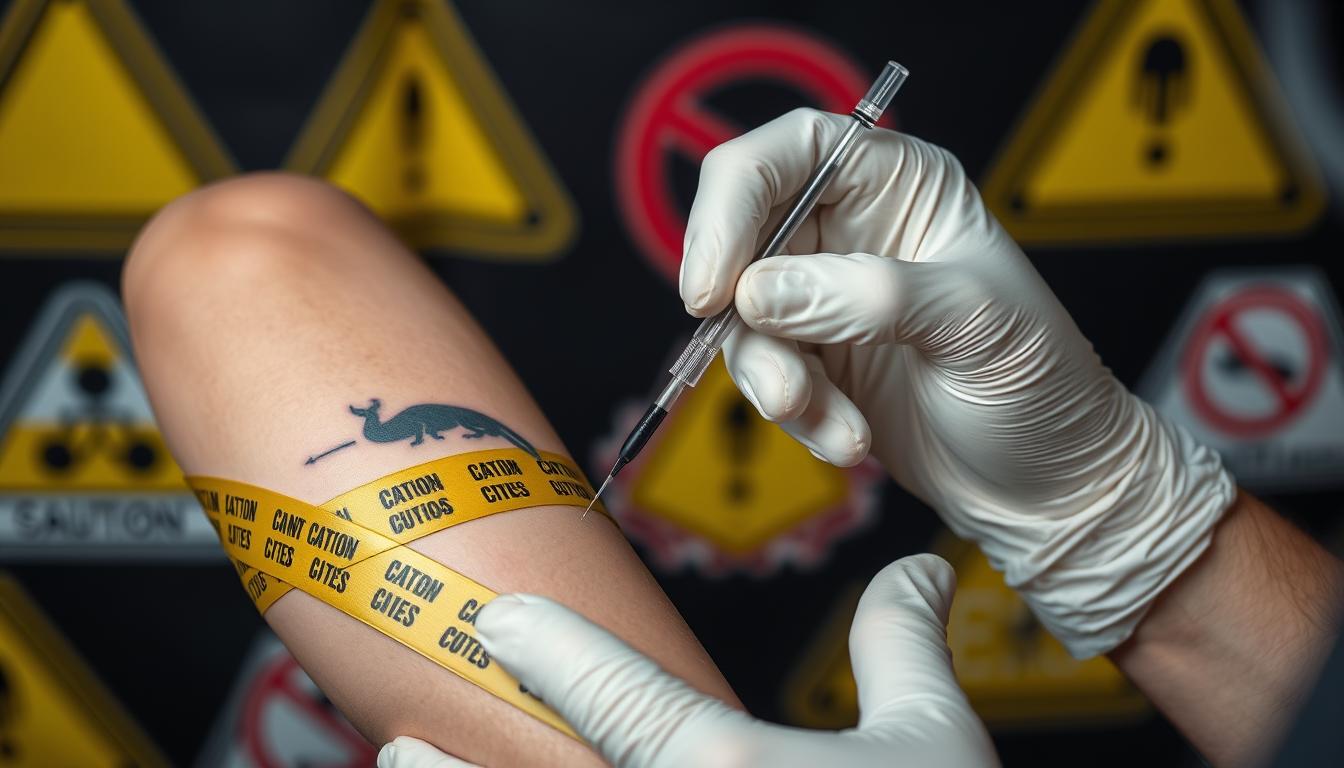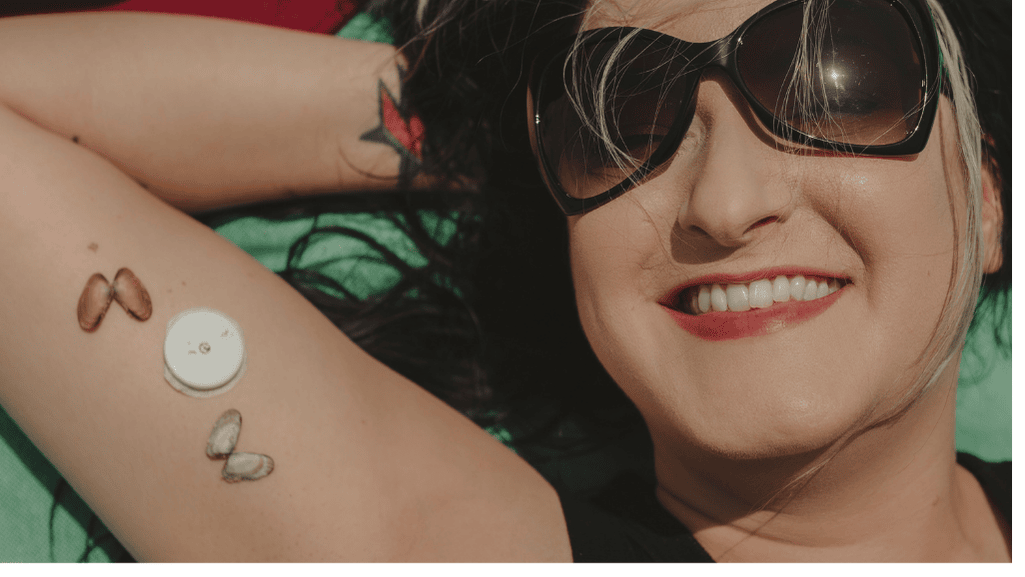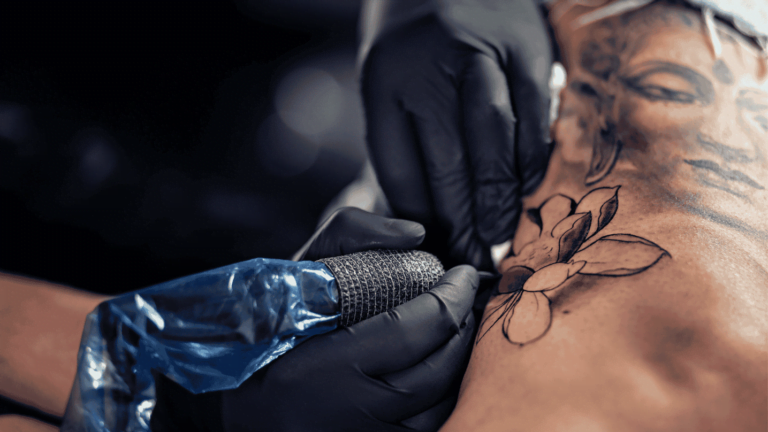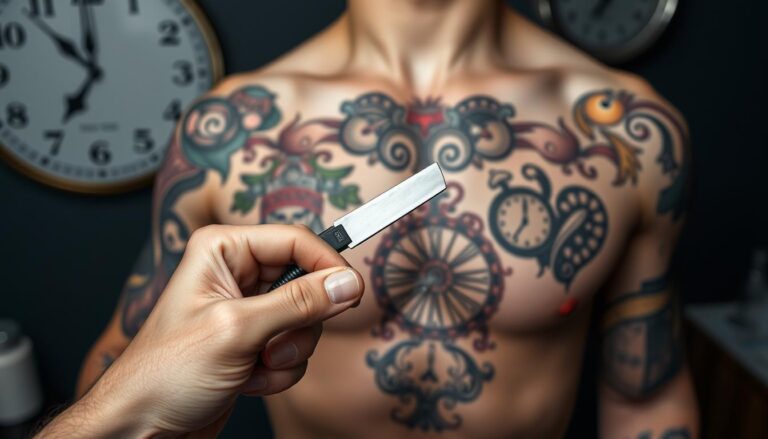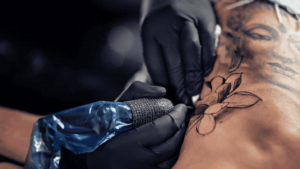If you have diabetes and are considering getting a tattoo, it is important to ensure that your blood sugar levels are well controlled before getting inked. Elevated blood sugars can increase the risk of skin infections, especially in type 1 diabetes. It is also crucial to consult with your healthcare provider before getting a tattoo to ensure there are no contraindications.
People with diabetes may get tattoos for self-expression, diabetes awareness and support, or as a form of medical identification. However, it is important to understand the risks involved and how to mitigate any adverse side effects.
Key Takeaways:
- Ensure well-controlled blood sugar levels before getting a tattoo with diabetes.
- Consult with your healthcare provider to identify any contraindications.
- Understand the risks involved and take appropriate precautions.
- Consider getting a tattoo for self-expression, diabetes awareness, or medical identification.
- Manage blood sugar levels and follow diabetic tattoo aftercare tips to prevent infections and promote healing.
Reasons for Getting a Tattoo with Diabetes
People with diabetes may choose to get a tattoo for various reasons. Some individuals see tattoos as a powerful form of self-expression, using designs or symbols that hold personal significance and meaning. Whether it’s a small, discreet tattoo or a larger, elaborate design, these tattoos can be an artistic way for individuals to convey their unique identity and story.
Moreover, tattoos can also be used to raise awareness and show support for diabetes. Many individuals with diabetes incorporate diabetes-related symbols such as the blue circle, a recognized symbol for diabetes, or a blue and gray ribbon with a drop of blood into their tattoo designs. These tattoos serve as a visible reminder of the challenges faced by those living with diabetes and can help generate conversations and support for the cause.
Additionally, tattoos can serve a practical purpose by functioning as a form of medical identification in case of emergencies. For individuals with diabetes, incorporating medical information, such as their type 1 diabetes diagnosis or an emergency contact number, into their tattoo design can provide crucial information to first responders and medical personnel.
While tattoos can hold personal significance and serve as a form of self-expression, awareness, and medical identification, it is important for individuals with diabetes to consider proper aftercare measures to protect their skin and prevent infections. Diabetic tattoo aftercare tips are essential to ensure the well-being of the skin and promote optimal healing.
The Diabetes Tattoo Design
When designing a tattoo, individuals with diabetes can work alongside a professional tattoo artist who specializes in custom designs. Communication with the artist is key in bringing the vision to life while considering any unique considerations or requirements due to diabetes.
It’s crucial to clearly communicate any specific diabetes-related symbolism or medical information that should be incorporated into the design. By collaborating closely with the artist, individuals with diabetes can create a tattoo that not only holds personal significance but also effectively conveys their message and medical information, if desired.
Risks and Considerations for Tattooing with Diabetes
Tattooing poses certain risks for people with diabetes. One of the primary concerns is the chronic elevation of blood sugar, which can impair wound healing and increase the risk of infection. Before getting a tattoo, it is crucial to manage blood sugar levels effectively. By maintaining stable blood glucose levels, individuals with diabetes can reduce the risk of complications during the tattooing process.
Ensuring the safety and cleanliness of the tattoo establishment is also essential. It is important to verify that the artist is licensed, as this ensures that they adhere to strict hygiene practices and use sterile equipment. Choosing a reputable artist and studio can significantly minimize the risk of infection or other adverse effects.
Diabetic skin care for tattoos is crucial to prevent infections and promote proper healing. Following the artist’s aftercare instructions is important for individuals with diabetes to ensure their tattoo heals well. This includes keeping the tattoo clean, avoiding exposure to sun and water, and using recommended ointments or creams to moisturize and protect the skin. Taking proper care of the tattooed area can help minimize the risk of infections and other complications.
In addition to blood sugar management and tattoo aftercare, people with diabetes should be cautious about getting tattoos in areas with poor circulation. Tattoos applied in these areas may take longer to heal and are more prone to complications. It is recommended to consult with a healthcare professional to determine whether tattooing in specific areas is suitable for individuals with diabetes.
While getting a tattoo can be a personal and meaningful choice, it is essential for individuals with diabetes to consider these risks and take necessary precautions. By closely managing their blood sugar, ensuring a safe and clean tattoo environment, following proper aftercare practices, and being mindful of circulation issues, individuals with diabetes can reduce the potential risks associated with body art.
Diabetic Skin Care for Tattoos
Proper skin care is crucial after getting a tattoo, especially for individuals with diabetes. These are some essential steps to follow for diabetic skin care for tattoos:
- Keep the tattoo clean and dry: Gently wash the tattooed area with mild soap and warm water. Pat it dry with a clean towel and avoid rubbing or scratching the tattoo.
- Moisturize the tattoo: Apply a thin layer of unscented, hypoallergenic moisturizer to keep the skin hydrated. Avoid using products with irritants or fragrances.
- Avoid direct sunlight: Protect the tattooed area from sun exposure, as it can cause fading and damage to the skin. Use sunscreen with a high SPF and ensure to cover the tattoo when out in the sun.
- Avoid soaking in water: Minimize exposing the tattooed area to water, especially swimming pools, hot tubs, and baths, as it can increase the risk of infection. Take quick showers instead of long baths.
- Listen to your body: Pay attention to any signs of infection, such as redness, swelling, pain, or discharge. If you notice any unusual symptoms, seek medical attention promptly.
By following these diabetic skin care tips, individuals with diabetes can ensure the proper healing of their tattoos and reduce the risk of complications.
Risks of Infection and Poor Healing
One of the primary risks associated with tattooing for individuals with diabetes is the increased susceptibility to infections and poor wound healing. Elevated blood sugar levels can impair the immune system, making it harder for the body to fight off infections. Therefore, it is crucial to manage blood sugar effectively before getting a tattoo.
Additionally, poor healing can occur in individuals with diabetes due to reduced blood flow and circulation in certain areas of the body. Tattoos applied in these areas may take longer to heal and are more prone to complications. It is recommended to discuss any concerns with a healthcare professional before getting a tattoo.
Comparing Tattoo Risks and Considerations for Individuals with Diabetes
| Risks | Considerations |
|---|---|
| Infection | Manage blood sugar levels effectively and ensure a clean and safe tattoo environment. |
| Poor wound healing | Monitor blood glucose levels and discuss tattoo placement with a healthcare professional. |
| Circulation issues | Be cautious of getting tattoos in areas with poor circulation and consult with a healthcare professional. |
Potential Complications and Allergic Reactions
When considering getting a tattoo, it is important for people with diabetes to be aware of the potential complications and allergic reactions that can occur. While tattoos are generally safe, there are certain risks that individuals with diabetes should be mindful of.
Infections and Impaired Wound Healing
Proper hygiene practices and adequate aftercare are essential to prevent infections after getting a tattoo. However, people with diabetes may have a higher risk of developing an infection due to impaired wound healing caused by high blood sugar levels. Elevated blood sugars can compromise the immune system, making it more difficult for the body to fight off infections.
It is crucial for individuals with diabetes to follow the post-tattoo care instructions provided by the tattoo artist. This includes keeping the tattoo clean and moisturized, avoiding excessive exposure to water, and not scratching or picking at the tattoo as it heals.
Allergic Reactions to Tattoo Ink
While rare, allergic reactions to tattoo ink can occur. Certain individuals may be more prone to allergic reactions, including those with diabetes. It is important to note that tattoo ink is not regulated by the FDA, and some ingredients in the ink may cause an allergic response.
If you experience any signs of an allergic reaction such as redness, itching, swelling, or excessive pain at the tattoo site, it is crucial to seek immediate medical attention. A healthcare professional can evaluate the reaction and provide appropriate treatment.
Potential for Keloid Scarring and Skin Conditions
Individuals with diabetes may be more prone to keloid scarring, which is an overgrowth of scar tissue that can occur after a tattoo. Keloids can be raised, itchy, and may extend beyond the boundaries of the tattoo. It is important to discuss the risk of keloid scarring with your tattoo artist before getting a tattoo.
In addition, people with pre-existing skin conditions like psoriasis or eczema may experience worsened symptoms in the area where the tattoo is applied. It is essential to consult with a dermatologist if you have any concerns about how the tattoo may affect your skin condition.
Overall, while there are potential complications and allergic reactions associated with tattoos, these risks can be minimized with proper precautions and care. By following the guidance of a reputable tattoo artist, maintaining good blood sugar control, and seeking appropriate medical attention if needed, individuals with diabetes can safely enjoy the art of body ink.
Conclusion
When it comes to getting a tattoo with diabetes, understanding the risks involved is crucial. Managing blood sugar levels and seeking guidance from healthcare professionals are fundamental steps towards ensuring safety. Additionally, proper aftercare and diabetic skin care for tattoos play a vital role in preventing infections and promoting healing.
It’s important to be mindful of potential complications and allergic reactions that may arise. By staying informed and seeking immediate medical attention if needed, individuals can enjoy body art while prioritizing their health and well-being. With precautions and informed decisions, people with diabetes can confidently embrace their love for body art.
Remember, diabetes and body art can coexist, but it is essential to prioritize safety and take the necessary measures to mitigate any associated risks. By combining responsible management of blood sugar levels, proper aftercare, and seeking professional guidance, individuals can confidently express themselves through tattoos while maintaining optimal well-being.
FAQ
Can people with diabetes get tattoos?
Why do people with diabetes get tattoos?
What are the risks and considerations for getting a tattoo with diabetes?
What are the potential complications and allergic reactions associated with tattoos for people with diabetes?
How can people with diabetes ensure safe tattooing and proper aftercare?
Forhad
Forhad's writing is not just about the artistry of tattoos or the latest trends in the industry; it's an exploration of the deep-rooted connections people have with their tattoos, reflecting personal narratives, cultural histories, and moments of transformation. Through a mix of in-depth features, personal narratives, and insightful analyses, he sheds light on the multifaceted nature of tattooing, revealing the emotional and cultural layers that lie beneath the surface.


